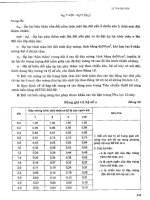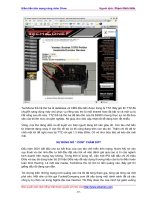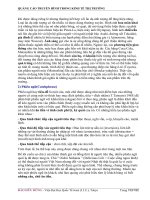Valuation maximizing corporate value phần 9 ppt
Bạn đang xem bản rút gọn của tài liệu. Xem và tải ngay bản đầy đủ của tài liệu tại đây (93.69 KB, 22 trang )
Create Action Plans 159
tives, and that achieving these objectives in this fashion will,
indeed, increase the overall value of the organization, the
task force should reconvene for an action planning work-
shop. The purpose of this session is to decide which individ-
ual or group or department is ultimately responsible for
achieving which objectives.
It is not necessary that a single individual or department
perform all the tasks required to obtain an objective. Efforts
can cross organizational lines. Likely interdepartmental
interfaces should be spelled out and highlighted so agree-
ment as to levels of involvement and time and resource
commitments can be anticipated. It is during such discus-
sions that a spirit of cooperation should be fostered and all
participants reminded that it is the organization working
together which creates the goal of marketplace differentia-
tion and long-term success.
Once responsibilities for each objective and related
strategies are clearly spelled out, the formal session is over.
The next step is for every team member to take the agreed-
upon strategic framework (from the top mission level all the
way through the strategy level) and present it to their staffs.
The intimate knowledge of the methodology behind and the
rationale for the framework obtained during the various
sessions involved in its creation is usually enough to ensure
its enthusiastic endorsement by the members of the organi-
zation. However, a high level of enthusiasm coupled with
some basic sales techniques should facilitate each original
team member’s chances for achieving buy-in from the staff
on the first go ’round. The goal is for the staff to agree that
the urgency and importance of achieving the stated objec-
tives are commensurate not only with the success of the
organization but also their long-term well-being.
160 EXECUTE FOR VALUE
However, if major objections, road blocks, and/or con-
flicts arise during the staff presentations, they should not be
overlooked or just set aside. Another action planning work-
shop should be scheduled where team members consider all
the feedback obtained from the organization. By now the
iterative nature of the overall process should be second
nature to the participants. Accordingly, they should calmly
reflect on the new internal input and, after referring to the
purposes and values elements of the mission, revise respon-
sibilities, objectives, and strategies as necessary in an appro-
priate way.
Once the revised framework is complete, it should be pre-
sented again to the members of the organization. Where
changes have been made, the reasons should be explained.
Where no changes have been made, in spite of protestations
from some members of the organization, the rationale behind
keeping things as they were should also be spelled out.
Remember it is unlikely any document will please all mem-
bers of an organization.
Once the strategic framework is complete down to the
strategy level and buy-in at all levels of the organization is
more or less complete, the next step is for every individual
with objective-achievement responsibilities to convene an
action planning workshop. Prior to doing so, however, each
team member should review the material on action planning
discussed later in this section.
The methodology for the staff action planning workshop
is very straightforward and similar to that used in previous
top management team workshops. The leader should be the
individual with overall responsibility for objective achieve-
ment. Breakout groups should be organized and sent off to
develop specific action plans indicating who, what, where,
when, how, and how much. Each breakout group generally
works on one strategy at a time, creating however many
action plans seem to be required to accomplish it fully.
Financial Considerations
When working with staff members on the creation of action
plans, regardless of which techniques and guidelines might
be employed, it is critical to stress that one of the key rea-
sons behind all the implementation effort is to increase the
overall value of the organization. The way this gets done is
by each individual and group making decisions that always
contribute to this end. The way to achieve this is to make
everyone aware of one simple, mathematical truth:
The value of the organization is enhanced each time an
investment is made that has a higher return than the
organization’s weighted cost of capital.
The participants need to know only one number—the organi-
zation’s weighted cost of capital (see Chapter 2’s “Determine
the Cost of Capital”). This number should be the same
regardless of which area of the organization is involved in
creating action plans.
1
The participants also need to know
how to calculate an estimated return on investment. Most
organizations supply calculators, economic models, or
spreadsheets that simplify this process. The participant
answers just a few questions related to the investment and the
return is calculated.
With the weighted cost of capital in one hand and the
return on the investment in the other, decision making is
simple. For example, if one expects to invest $100 at the
Create Action Plans 161
management information systems. Indirect methods utilize
imprecise means such as symbolic actions aimed at altering
the organization’s culture. Regardless of which method is
being employed, however, the leader involved should be
aware that one of the biggest challenges to be faced is
removing the emotion and fear that staff members typically
bring to such processes. Clear communications as to
methodology, expectations, and roles to be played go a long
way toward quelling such concerns.
To better understand the direct approach, let us consider
the first strategy under the first objective for ABC Company
(see Chapter 6’s “Review The Selected Strategies”). This
strategy is to “Increase R&D staff by 50%,” and one way
to achieve the objective is to “introduce one new device
every quarter for the next two years.” One possible direct
approach would be to create a detailed action plan spelling
out who, what, where, when, and how.
Mr. Smith, Director of Human Resources will run help-
wanted advertisements in the local Sunday paper for six
months starting next week; Mr. Smith will authorize a
project aimed at identifying competitive compensation
and benefits for R&D personnel offered by other com-
panies in the area; a committee of Mr. Smith, Ms.
Jones, Manager of Technology, and Mr. Jackson, Chief
Financial Officer, will develop a statement of job speci-
fications and candidate requirements to be used in the
advertisement and screening process; all submissions
will be reviewed by the committee weekly and candi-
dates selected will be invited to visit promptly. Up to
$5,000 in advertising and 50 labor hours will be spent
Create Action Plans 163
to generate up to ten offers to ensure the two positions
which need to be filled will be done so within eight
months.
Another direct approach would be to institute a manage-
ment information systems procedure. For example, screen-
ing criteria to apply to the employee database will be run
periodically to identify potential new R&D staff transfers
within the organization. Also, revisions to budgets and the
organization chart should be made (other direct methods)
to reflect the increased expenses and management time
associated with new hires.
Now let us assume ABC is also interested in using indi-
rect means that will support the same objective and strat-
egy discussed above. By using the employee newsletter and
press releases, the company reminds all its stakeholders it
has a continuing commitment to innovation in the devices
it sells and to overall corporate growth. This formal, writ-
ten communication helps paint a picture of a nice place to
work for the candidates identified by the direct means and
may even generate unsolicited inquiries from other inter-
ested parties. At staff meetings, managers may share stories
of bonuses and promotions employees have received in the
past for referring candidates or submitting product
improvement ideas, further communicating and inculcating
the organization’s values of excellence, rewards, and
growth. Flowers in the R&D reception area, plaques on the
walls, well-designed research smocks, clean facilities, above-
average research capabilities and access, and other symbolic
yet substantive enhancements all contribute in an indirect
way to achieving the implementation of the strategy and the
objective.
164 EXECUTE FOR VALUE
Create Action Plans 165
The main lesson to be learned here is that a combination
of direct and indirect methods is generally more effective in
achieving objectives than an approach that just focuses on
one or the other. Also, by bringing in different departments
and functions, the expertise resident therein can aid in more
efficient (less costly) and more effective (longer lasting)
results.
Practical Aids
With so many different team members off working with
their staff members to design action plans, the chances for a
breakdown in communications and overall confusion multi-
ply. One way to minimize the risk of this happening is to
create consistency in the way plans are evaluated, docu-
mented, communicated, and monitored. Because each orga-
nization is different, there is no one way that is likely to
provide the ideal solution for everyone.
The ABC Company uses a structure which is identical
across all departments. It appears as Exhibit 7.1.
Notice how the relevance of the action plan is emphasized
right at the top of the page. The ABC Strategic Framework is
emphasized and tied into by requiring the Long-Term Goal
and Niche to which the action plan is related to be stated.
The supporting objective and specific strategy are also high-
lighted. This reminds the staff that the action they are plan-
ning is important to the overall success of the organization
and shows them specifically how this is so.
If repetition is one of the keys to ownership, this form
does a good job of creating a sense of organizational entre-
preneurship among all those involved in action planning. The
columns underneath the heading area allow for multiple









